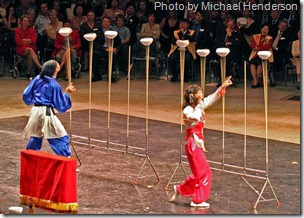Archive for April, 2009
Trick Yourself Into Saving More Money
 Do you get a rush when you come home with a bag of goodies from your favorite store? Does your heart start to beat a little faster after clicking “Buy Now” online?
Do you get a rush when you come home with a bag of goodies from your favorite store? Does your heart start to beat a little faster after clicking “Buy Now” online?
Refocuser is all about life-improvement through appropriate focus. I’d bet that living in today’s economy makes being financially responsible an important goal for just about everybody reading this blog. And while I’m not always going to go into depth on money tactics, it’s worth calling out just one way I’ve found that works well to curtail spending.
I’ve discovered that when I would purchase something on impulse, I rarely regretted it (I don’t do regret). But in most cases, had I just waited out the impulse a bit, it likely would have subsided without requiring me to pull out my wallet. So I started thinking about how to get that feeling of instant gratification without plunking down hard-earned cash.
The trick I’ve found is to convince myself that I’ve just purchased something even when I haven’t. The satisfaction I’d get from clicking “Buy Now” is fulfilled without spending any money. And what I’m really doing is satisfying the urge I have to be a packrat and accumulate stuff – which in many cases is what spurs any impulsive purchasing. The trick here is that I’m actually accumulating information (for free) about what I’d like to acquire, while not actually acquiring anything tangible at all.
I think about this as closing an open loop. When you want something badly enough, your mind sees it as unresolved. So you tend to dwell on it. You think about it, mull over it, and beat yourself up until you decide if you’re going to act on the impulse. The key is to “close the loop” as quickly as possible to put your mind at ease. It just so happens that buying something can close that loop, but there are other ways to convince yourself that you’ve figured out what to do with something.
Bouncing at Zero – “ZBB” in Life
 In software development at Microsoft we have a concept that I’ve always found personally relevant. It’s called Zero Bug Bounce (ZBB) and it refers to a period in time in which the development team is consistently “bouncing at zero bugs” every single day. At this point in the project, all active bugs in the software have been looked at and either punted or fixed – and the team’s fix rate (or the rate at which they’re able to fix bugs) is greater than the team’s incoming rate (or the rate at which new bugs are being opened). The code is almost ready to see the light of day in the real world.
In software development at Microsoft we have a concept that I’ve always found personally relevant. It’s called Zero Bug Bounce (ZBB) and it refers to a period in time in which the development team is consistently “bouncing at zero bugs” every single day. At this point in the project, all active bugs in the software have been looked at and either punted or fixed – and the team’s fix rate (or the rate at which they’re able to fix bugs) is greater than the team’s incoming rate (or the rate at which new bugs are being opened). The code is almost ready to see the light of day in the real world.
I always love hitting and maintaining ZBB because there’s a complete sense of control over the project. Every member of the engineering team knows each and every bug and you can feel the momentum pulling you towards the eventual finish line. When that finish line means half a billion people are going to start downloading or using the thing you’ve been working on, it’s electric. Which is part of the reason I love my day job unlike most bloggers 😉
Several years ago I started thinking about a number of things in my life as being at ZBB in order to give myself a mental framework – and more importantly a visual – for getting to zero and bouncing off of it regularly. The list is actually quite extensive and includes my snail mail box, bills I need to pay, all of my various electronic inboxes, voicemails, RSS feeds, and so on. When these things aren’t under control I can immediately feel my blood pressure start to rise because it means I’m not being effective and important things could be slipping through the cracks and hitting the floor.
Keep the Plates Spinning
For those who haven’t heard the phrase “keep the plates spinning”, it refers to a circus trick involving about a dozen spinning plates on the end of poles (see photo to the right). The performer has to keep all the plates spinning because if any one of the plates slows down too much, it’s going to fall off the pole and smash into pieces on the floor. It’s fun to watch. The performer is constantly evaluating which plates are OK and which are trending towards disaster, and they’re making second-to-second judgments about how best to keep all the plates spinning together.
Sound familiar? Replace “performer” with your name and replace “plates” with responsibilities like work, family, or personal health. We’re just like those circus performers, running between our various responsibilities and commitments to keep them spinning just enough so they don’t fall off the sticks. Focus too long on one plate, no matter how important it seems, and you’ll find that the others will crash to the floor. Try and keep them all spinning at the same high velocity and you’ll almost certainly collapse out of exhaustion – it’s not sustainable.
While focus is about choosing a few things and doing them well, it’s rarely about choosing just one thing and doing that one thing well. That’s impossible to do – I can be a good father, but if I fail miserably to earn a paycheck, my daughter doesn’t eat. I can be great in the office, but if i don’t take care of myself physically and emotionally, I won’t have the energy to keep it up for very long (and while my daughter will eat, she wouldn’t know me from Stanley). We have to be multifaceted to some degree in our day-to-day approach.
So what do you do if you want to keep the plates spinning at various speeds consistently?
Be a Thermostat, Not a Thermometer
 Seth Godin makes an interesting observation in his book Tribes about the key difference between a thermometer and a thermostat and how it’s reflected in human nature. He says that a thermometer is great for identifying when something is broken after the fact while a thermostat does it’s best job to regulate temperature to stay in sync with its environment. Thermostats are leaders while thermometers are just squeaky wheels.
Seth Godin makes an interesting observation in his book Tribes about the key difference between a thermometer and a thermostat and how it’s reflected in human nature. He says that a thermometer is great for identifying when something is broken after the fact while a thermostat does it’s best job to regulate temperature to stay in sync with its environment. Thermostats are leaders while thermometers are just squeaky wheels.
To put it another way:
- Thermometers like to criticize once a direction is chosen. They’re always first to notice when something is wrong, but can’t take the necessary steps to fix it. They’re the armchair quarterbacks of the world and are great at telling you what you already know. The thermometer has an ability to lead only in so much as hindsight is 20/20. They can’t plan or adapt to changes.
- Thermostats take the temperature of the room first and then put a plan in place to adapt. They’re the leaders and the visionaries, and the people you rely on to stay calm in a crisis and lead you to the next level. Thermostats are able to work past criticism and negativity and push forward even when the odds are against them. Thermostats exhibit self-control and stability.
Naturally there are corollaries in the business world but what about for personal growth and achievement? When I read this I immediately thought about the high-achievers I know and how they approach their lives. They’re all gifted in keeping things in balance and staying in control – events and people don’t inject drama into their lives because they don’t let them. They understand the factors at work and adapt accordingly with time to spare. They aren’t prone to wild swings in “temperature”.
This description also reminds me of one of my favorite Bruce Lee quotes, which is a key lesson in Zen philosophy: “Notice that the stiffest tree is most easily cracked, while the bamboo or willow survives by bending with the wind.” Thermostats are masters at adaptation.
Thermostats don’t like to spend time with thermometers because it’s almost always counter-productive for them, making everything harder than it needs to be. Thermometers hold people back through negativity and second-guessing while thermostats do what needs to be done. It’s all about learning, adjusting, and driving ahead.
So… are you a thermostat or a thermometer?
Strength Training 101
 Physical conditioning, emotional strength, and mental focus are interrelated and natural precursors to one another. A strong body drives intestinal fortitude and a focused mindset just as a clear, focused mindset can develop a strong body. All three sides of the triangle are a requirement for the kind of focus this blog is all about; it’s hard to achieve self-actualization if you’re missing one of these prerequisites. This counter-balance is often described as mind-body-spirit in various spiritual practices.
Physical conditioning, emotional strength, and mental focus are interrelated and natural precursors to one another. A strong body drives intestinal fortitude and a focused mindset just as a clear, focused mindset can develop a strong body. All three sides of the triangle are a requirement for the kind of focus this blog is all about; it’s hard to achieve self-actualization if you’re missing one of these prerequisites. This counter-balance is often described as mind-body-spirit in various spiritual practices.
It’s clear that training the mind in various ways (NLP, visualization, meditation) can help develop physical skill as much or more than rehearsal of the activity itself. But just as the mind drives the body, the body can drive the mind as well. Confidence and real strength can be derived from physical activity whether it’s through enhanced coordination, a sense of empowerment and control over something, or as an avenue for achieving flow.
Looking at empowerment and control alone, it’s clear that overcoming challenges – small and large – can increase self-esteem and confidence. And having confidence in your abilities in one area can translate to other areas of life, effectively parlaying success in one controlled arena to other potentially less controlled ones. Tony Robbins has his conference attendees walk on fire on day one of a retreat to show them how their limiting beliefs have been holding them back, and once they’ve done something they previously thought was impossible, they’re more open to tackling more personal challenges.
In many ways building muscle has this same effect on people.
Increase Focus With Low-fat String Cheese and an Apple
(Happy Easter!)
 Keeping yourself satiated throughout the day is one surefire key to focusing. You can’t really focus if you can’t think, and you can’t think unless you’re constantly replenishing your brain fuel. Snacking in-between regular meals is one of the best ways to do this.
Keeping yourself satiated throughout the day is one surefire key to focusing. You can’t really focus if you can’t think, and you can’t think unless you’re constantly replenishing your brain fuel. Snacking in-between regular meals is one of the best ways to do this.
With snacks you’re able to maintain “normal” eating times for social purposes (although it’s recommended you eat smaller meals rather than “typical” portions). But by supplementing with simple snacks, you keep yourself from getting hungry between meals which has a number of benefits: 1) you’re less inclined to eat a stack of donuts out of desperation, 2) you keep your blood sugar level steady which leads to an enhanced mood and stronger focus, and 3) your metabolism will have a higher steady state which can lead to accelerated fat loss. What’s not to love about this?
In other words: eating just 2-3x daily is for losers. You need to eat more often. And the easiest way to do this is to snack, snack, snack. Keeping your snacks small and simple to prep is also key, which is why Greek yogurt, almonds, and green tea is so great – and string cheese and an apple are as well.
Finding Time to Write (Or to Get Into Creative Mode)
 I’ve written this entire blog, past and future, in my head a dozen times over the last decade. I’ve mentally written millions of words and crystallized my perspective on the topics this blog will cover – but take a guess at what I forgot to do. Write it all down! What some would consider the easy part. Reason? Lack of time. Or so I’d been telling myself for years.
I’ve written this entire blog, past and future, in my head a dozen times over the last decade. I’ve mentally written millions of words and crystallized my perspective on the topics this blog will cover – but take a guess at what I forgot to do. Write it all down! What some would consider the easy part. Reason? Lack of time. Or so I’d been telling myself for years.
Everyone has probably heard these phrases:
- Winners make the time!
- If you don’t have the time, you don’t want it badly enough.
Naturally I agree with those statements in theory, but it’s always a lot harder to turn them into practice. How do you make the time when there are a thousand other important things pulling at your attention? The “answer” to that question is bigger than this one post – it’s the focus of this blog – so for now I’m going to cover the “rule set” I’ve followed for sitting down and writing this blog. These rules have worked well for the (very) short amount of time I’ve been employing them, and I expect they’re just the start of a longer list over time. They cover writing as an activity but could also be extended to just about any creative activity – simply replace the word writing with painting, dancing, graphic design, or whatever else you’d like to focus on.
Before jumping in however, it’s important that you’ve already made the commitment to yourself that whatever it is you want to invest in creatively is important to you. Do you consider it an important part of your core values or mission? Is it one of your top 3 focus areas? Do you have both long-term and short-term goals relating to this activity and have you written them down? If you’ve answered no to any of those questions, you have to ask yourself if you’re actually going to “make the time” for something that doesn’t align with who you ultimately want to be. Do you “want it badly enough”? Think about it before taking the next step.
Pick Your Top 3 Focus Areas… and Drop Everything Else
 Focusing on what matters most to you is the only way you can make material progress towards your goals. Typically when you talk to people who are so stressed out they can’t see straight, they complain that they simply have too much to do and feel overwhelmed. When you dig a little deeper, you almost always discover that they’re trying to do too much to begin with and are trying to be too many things to too many people. They don’t have a North Star to keep them moving towards their goals and may not even know what’s actually important to them. They just feel like they’re failing at everything and need help.
Focusing on what matters most to you is the only way you can make material progress towards your goals. Typically when you talk to people who are so stressed out they can’t see straight, they complain that they simply have too much to do and feel overwhelmed. When you dig a little deeper, you almost always discover that they’re trying to do too much to begin with and are trying to be too many things to too many people. They don’t have a North Star to keep them moving towards their goals and may not even know what’s actually important to them. They just feel like they’re failing at everything and need help.
A while back I was at a conference with a senior executive of one of the most successful companies in the world. An audience member asked him how he got to where he is, expecting an answer along the lines of “I work all the time”, “This company is my life”, or “I’m on email at midnight and then again at 5am”. His answer was simple. He said, “I realized early on that I couldn’t do everything if I wanted to be good at anything. So I thought about the three things that were most important to me and pretty much eliminated the rest. This means I can excel in those three areas without any guilt since I know these are the most important to me. And I don’t spend time regretting what I’m not doing because it’s a choice I made.”
He called it ruthless focus. He probably used the word ruthless because it was as much about the things he wasn’t going to do as it was about the things he was doing. Some of the other things he wanted to do just weren’t going to get his attention if he were going to buckle down and focus on his top three things. And he had come to terms with that.
5 Keys to Overcome Your Fear
 Fear is a tough topic to cover as it motivates so much of what we do on a day-to-day basis. Even when we’re not fully aware of it, fear has its hooks in us and is dragging us down. Naturally we aren’t talking about phobias or that adrenaline rush you get when you skid to a stop right before rear-ending the car in front of you on the freeway. Fear is so much bigger than that. Fear drives almost all of our actions. Why we do some things and why we avoid others, why we get close to some people and push others away. In the process of life, fear is the single biggest hindrance to goal achievement. It’s just such an important topic to cover.
Fear is a tough topic to cover as it motivates so much of what we do on a day-to-day basis. Even when we’re not fully aware of it, fear has its hooks in us and is dragging us down. Naturally we aren’t talking about phobias or that adrenaline rush you get when you skid to a stop right before rear-ending the car in front of you on the freeway. Fear is so much bigger than that. Fear drives almost all of our actions. Why we do some things and why we avoid others, why we get close to some people and push others away. In the process of life, fear is the single biggest hindrance to goal achievement. It’s just such an important topic to cover.
As I talked about recently in the series on Flow, fear is best described as an acronym: ‘False Evidence or Expectations Appearing Real’ or ‘Failure Expected Action Required’. Fear occurs when we have negative expectations of a situation – even when those expectations are completely unfounded. So many people just assume the worst is going to happen when things are ambiguous. Making this assumption leads to a quick “recoil effect” which isn’t dissimilar from what you do when you actually encounter a negative outcome to an action.




